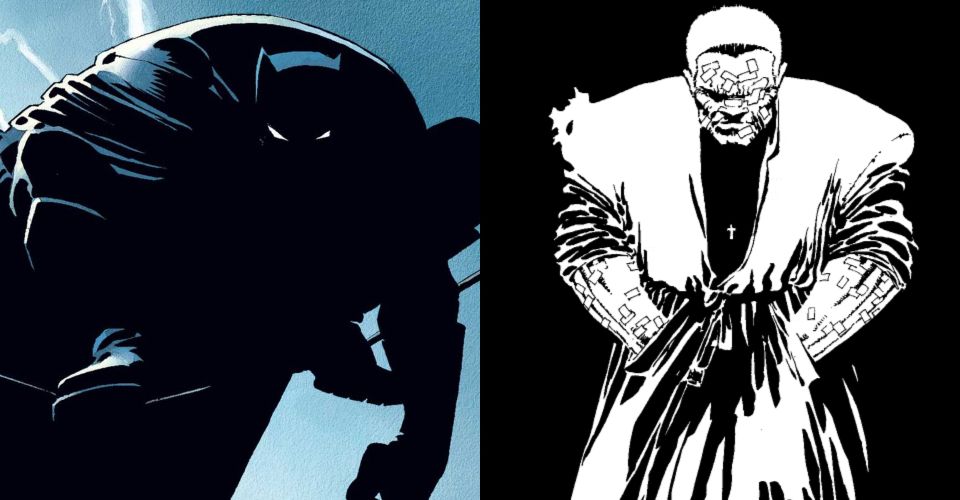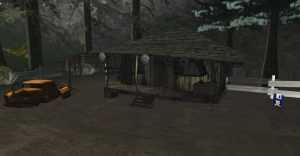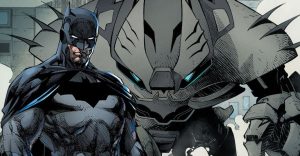Frank Miller: His 9 Best Comics

It almost goes without saying that, for the past 40 years, Frank Miller has been and continues to be one of the biggest names in the comics industry, making a name for himself with such seminal works as 300 and The Dark Knight Returns–to say nothing of the numerous films he’s written and directed.
Equal parts prolific and profound, Miller has captivated longtime readers and drawn flocks of new fans to the comic stands with his signature combination of gritty, noir storytelling and his indelible art style, establishing himself as one of the most instantly recognizable author/artists in the industry. Reinventing the medium and genres he works in time and time again with seemingly effortless ease, Miller’s comics stand as some of the most notorious and high-profile works of graphic literature ever produced.
9 Sin City

A series of neo-noir stories written between 1992 and 2000, Miller’s Sin City comics are some of the finest examples of minimalist, black-and-white storytelling around–stunningly taking advantage of the monochrome form via groundbreaking use of negative space and expressionist, high-key lighting.
The books relate the misadventures of, primarily, Marv and Dwight–two imposing, grizzled men–as they navigate the seedy underworld of the fictional Basin City, encountering a never-ending sea of sex, alcohol, and violence along the way. Winning Miller near countless Eisner awards, Sin City remains a triumphant work of creator-owned comics that raises the bar for poignant and elegant visual spectacles to staggering heights.
8 The Dark Knight III: Master Race

The sequel to the sequel to his 1986 classic, Master Race is one of Miller’s most successful superhero series of the past several decades, expanding his vision of a dystopian future DC Universe to include many of the most high profile and recognizable heroes–as its predecessor TDK2 did, but to much greater effect.
The first issue of the series stormed into comic shops in 2015 and dominated the bestseller list by selling over 400,000 copies the first month alone, demonstrating beyond a shadow of a doubt the continued relevancy and clout of one of the medium’s most famed creators.
7 Daredevil

Frank Miller began writing and penciling Daredevil for Marvel in the early ’80s, and in doing so changed the trajectory of the character for good. Once a b-lister published in a failing book with paltry sales, Miller elevated the character of Matt Murdock to superhero comics royalty with his daring noir tales and gripping, realist artistic renderings.
Miller’s haunted, tragic vision of a hero beset on all sides by death, despair, and moral quandary re-examined what form superheroes would take in the late Twentieth Century, setting the stage for a deepening trend in the industry towards thematically darker, mature books.
6 Give Me Liberty

Written in 1990 after his departure from DC Comics, Give Me Liberty marks Miller’s first collaboration with legendary comics artist Dave Gibbons (of Watchmen fame), as the two unite to tell a tale of a dystopian future America dominated by mega-corporations and private armies, following the exploits of Martha Washington: a heroic young woman hellbent on restoring a sense of justice to the United States.
Though not illustrated by Miller himself, the comic is blessed with his unique, prophetic vision of the socio-political state of things yet to come, making it a searing and relevant commentary that is lent inexpressible credibility by the iconic style of one of comics’ most distinguished political dystopia artists.
5 Batman: Year One

Returning to write the character with whom he crafted his most enduring triumph The Dark Knight Returns just a few years earlier, Frank Miller’s four-issue story arc Batman: Year One represents yet another high-water mark in the comics industry achieved during the late ’80s featuring the caped crusader–alongside other classics such as The Killing Joke and Arkham Asylum.
The book tells the story of a young Bruce Wayne, the prodigal son recently returned to Gotham with the training and tools under his belt to start a one-man war on crime, where in the process he encounters his future ally and Batman staple James Gordon, himself learning to navigate the dark waters of Gotham’s criminal underground.
4 Hard Boiled

Winning an Eisner Award for himself and his artist collaborator Geoff Darrow in 1991, Hard Boiled represents a wild shift in both content and style for Miller. While maintaining a strong emphasis on noir and crime thriller tropes, it’s futuristic setting along with its cyberpunk sensibilities propel it into realms of Bladerunner-esque science fiction rarely tread by Miller.
Though not drawn by Miller, the art is nonetheless just as captivating as any of his own work, and the spectacular intricacy and detail with which Darrow fills his illustrations create a mesmerizing effect that invites the eye to wander across and explore all the nooks and crannies of the crowded tableaux.
3 300

Remarkable not only for the quality of its storytelling, illustrations, and wonderful painted colors, 300 also broke all sorts of artistic and presentational boundaries with the publication of its collected edition in 1999.
Printed on paper nearly twice as wide as a standard 6-5/8″ comic book, the aspect ratio of the pages and the sweeping scale of Miller’s compositions lend the artwork an imposing, cinematic quality. This, in combination with the work’s grandiose, historical subject matter, paints 300 in the style of a no-holds-barred, spared-no-expense 1950s Hollywood Panavision epic–injected with a healthy dose of gratuitous and graphic bloodshed to boot.
2 The Dark Knight Returns

Commonly cited not only as one of, if not the greatest Batman story ever put to the page, but also as one of the most significant achievements in comics literature period (written during the most prolifically revolutionary period in comics history), The Dark Knight Returns can, in many ways, be considered the defining Batman ur-text. More so than the character’s introduction in Detective Comics #27, Adam West’s 1960s TV tenure, or the JLA’s debut in The Brave and the Bold #28, Miller’s Batman provides the archetypal template over which subsequent creators would lay the particulars of their stories–variations on the brooding, violent theme first played by Miller.
The trend of psychologically sophisticated heroes existing in dark worlds of tragedy and existential conflict established by The Dark Knight Returns influenced not only the trajectory of Batman comics for the next four decades but also the cultural conception of the superhero itself–with all of the major publishers re-casting their mainstay creations in the light of Miller’s tortured, “mature” vision.
1 Ronin

Ronin ranks among the most intriguing and unusual mainstream Western graphic novels produced in the early ’80s; its wildly inventive and genre-bending techno-samurai thriller remains an astonishing example of how comics creators can make the system work for them and deliver the freedom to push the limits of the form to the bleeding edge. Originally slated to be published by Marvel, Miller was convinced to partner with DC for the book after he was offered near-complete creative liberty with regards to both the content and the publication format of the book.
In response, he stipulated that the series would be printed on higher quality paper stock akin to that used by many French publishers at the time (such as Humanoids, the publisher of Jodorowsky and Moebius’ The Incal, which had a significant influence on Miller’s own art style in Ronin), and demanded it be published in 48-page installments with no advertisements. The pièce de résistance of Miller’s truly pioneering scripts, illustrations, and format of the series resides in the climactic destruction of a megalithic industrial compound: a breathtaking, explosive piece of art rendered in a massive fold-out composition spanning four standard-size comics pages placed end over end–a publishing stunt of sublime execution that has very rarely, if ever, been replicated in a DC or Marvel production.
About The Author

















